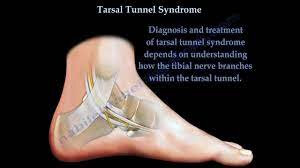The most prominent foot problems
Tarsal tunnel syndrome is pain in the ankle and foot, and sometimes in the toes due to compression or damage to the nerve that supplies the heel and the sole of the foot (posterior tibial nerve).
Symptoms include a burning or stinging pain in people when they walk or wear certain shoes.
The diagnosis is based on an examination of the foot and a nerve conduction study.
It is necessary to inject corticosteroids, use orthotic devices, and resort to surgical treatment in some cases to relieve pain.
The posterior tibial nerve extends under the back of the calf, through a fibrous canal (tarsal tunnel) near the heel and into the sole of the foot. When the tissues surrounding the tarsal tunnel become inflamed, they may swell and put pressure on a nerve (nerve compression), causing pain.
Disorders that may cause or contribute to tarsal tunnel syndrome include a fracture, ankle swelling due to heart or kidney failure, and an underactive thyroid gland (hypothyroidism). Disorders such as gout or rheumatoid arthritis also cause joint inflammation. Poor posture of the foot when the ankle is severely bent inward may also contribute to compressing the nerve within the tarsal tunnel.
Symptoms
Pain is the most common symptom of tarsal tunnel syndrome, as it is burning or tingling and may occur when standing, while walking, or wearing a special type of shoe. The pain is localized around the ankle (usually the inner side) and usually extends to the toes and worsens during walking and disappears with rest. Pain may also occur during the rest period as the disorder progresses.
The diagnosis
The doctor examined the foot
Sometimes nerve conduction studies
A doctor should move the affected foot in various directions during the clinical examination to diagnose tarsal tunnel syndrome. For example, a puncture of the affected or compressed area under the ankle bone often causes a tingling feeling (called a tinel sign) that may extend to the heel, arch, or toes.
Nerve conduction studies may help determine the cause or degree of injury, especially when investigating the possibility of surgical treatment.
Treatment
Corticosteroid injections
Orthotic devices
Sometimes surgery
An injection of a combination anesthetic and a corticosteroid into the area can relieve the pain.
Other treatments involve twisting the foot by placing specially manufactured devices (orthoses) in the shoe.
Surgery may be necessary to relieve nerve pressure when other treatments have failed to relieve pain.





